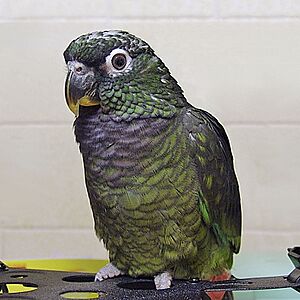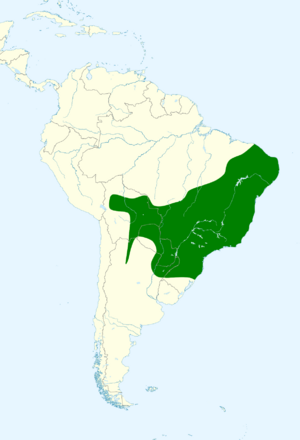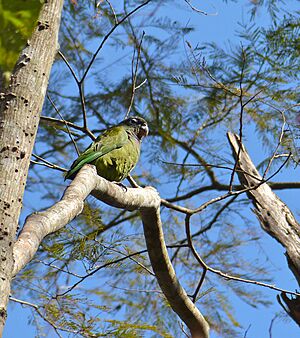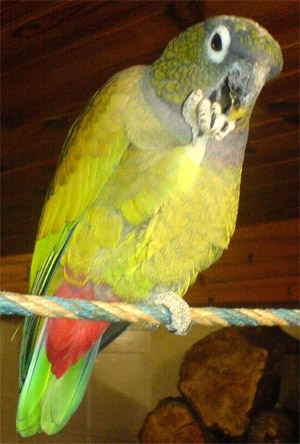Scaly-headed parrot facts for kids
Quick facts for kids Scaly-headed parrot |
|
|---|---|
 |
|
| Conservation status | |
| Scientific classification | |
| Genus: |
Pionus
|
| Species: |
maximiliani
|
 |
|
The scaly-headed parrot (Pionus maximiliani) is a colorful bird found in South America. People also call it the scaly-headed pionus or Maximilian's parrot. You can find these parrots in countries like Brazil, Bolivia, Argentina, and Paraguay. They belong to the group of parrots known as New World parrots.
Contents
What's in a Name? (Taxonomy)
The scaly-headed parrot has four main types, called subspecies. Think of them like different versions of the same bird, each living in a slightly different area.
- P. m. maximiliani (Kuhl, 1820)
- P. m. siy Souancé, 1856
- P. m. lacerus Heine, 1884
- P. m. melanoblepharus Miranda-Ribeiro, 1920
This parrot is closely related to the red-billed parrot. The name maximiliani comes from Prince Maximilian of Wied-Neuwied. He was a nobleman and naturalist who explored Brazil a long time ago.
In Brazil, people have special names for this parrot, like cocotas or maritacas. These names come from an old language called Tupi, meaning "noisy bird."
How to Spot a Scaly-Headed Parrot (Description)
Scaly-headed parrots are about 25 to 29 cm (9.8 to 11 in) long. That's about the length of a ruler! They weigh around 233 to 293 g (8.2 to 10 oz), which is similar to a can of soda.
The most common type, P. m. maximiliani, has a dark brown head. The rest of its head and neck are a dark greenish-bronze color. The edges of these feathers are darker, making them look like scales. This is how the parrot got its name! They have white skin around their eyes. Their back and wings are dull green. Their throat and upper chest are a dull blue, which turns yellowish-green on their belly. The feathers under their tail and the base of their tail are red. The inner tail feathers are green, and the outer ones are blue. Young parrots have a lighter green head and less blue on their chest.
Other types of scaly-headed parrots have slight differences:
- P. m. melanoblepharus is bigger and has darker green and blue colors. The skin around its eyes is also dark.
- P. m. siy is darker than the main type and has a reddish-purple chin and throat.
- P. m. lacerus is like siy but larger, with more bright blue on its chest.
Where Scaly-Headed Parrots Live (Distribution and Habitat)
These parrots live in different parts of South America:
- P. m. maximiliani lives in northeastern and east-central Brazil.
- P. m. siy is found in central and southeastern Bolivia, Paraguay, and parts of Brazil and Argentina.
- P. m. lacerus lives in northwestern Argentina.
- P. m. melanoblepharus is in southeastern Brazil, eastern Paraguay, and northeastern Argentina.
Scaly-headed parrots can live in many different places. In drier areas, they like forests where trees lose their leaves. In more humid places, they live in evergreen forests, where trees stay green all year. In Brazil, they can be found up to 1,500 to 1,600 m (4,900 to 5,200 ft) high, and in Argentina, up to 2,000 m (6,600 ft).
Some scaly-headed parrots have been seen living and breeding in parks in Malaga, Spain. These are called feral parrots, meaning they are wild but came from pet parrots that escaped. One female scaly-headed parrot in Spain even had babies with a male orange-winged amazon!
How Scaly-Headed Parrots Live (Behavior)
Daily Movements
Scaly-headed parrots usually stay in the same area all year long. They don't migrate far away.
What They Eat (Feeding)
These parrots enjoy eating many different things. They feed on seeds, flowers, and fruits from various plants.
Reproduction and Life Cycle (Breeding)
Scaly-headed parrots build their nests in holes they find in trees. The time of year they breed can change depending on where they live. When kept by humans, they usually lay four or five eggs. The baby parrots stay in the nest for about nine weeks after hatching before they are ready to fly.
What They Sound Like (Vocalization)
Scaly-headed parrots are known for their calls. Some people describe their calls as very high and shrill, like "teer-teer-teer--." Others say their main flying call is a repeated "cra-cheh" or sometimes just "crreeh" or "cheh." They also make many different "conversational" sounds when they are sitting on a branch.
Is the Scaly-Headed Parrot Safe? (Status)
The IUCN (a group that checks on animals) says the scaly-headed parrot is of "Least Concern." This means they are not currently in danger of disappearing. They live in a very large area, but their total number is not known. However, experts believe their population might be getting smaller.
The biggest threat to these parrots is the pet trade. People sometimes illegally catch them to sell as pets, especially in Argentina. Even though this is against the law, it still happens, though less often than it used to. The good news is that they are still common in southern Brazil and found in many places in Paraguay and Argentina.
See also
 In Spanish: Loro maitaca para niños
In Spanish: Loro maitaca para niños




